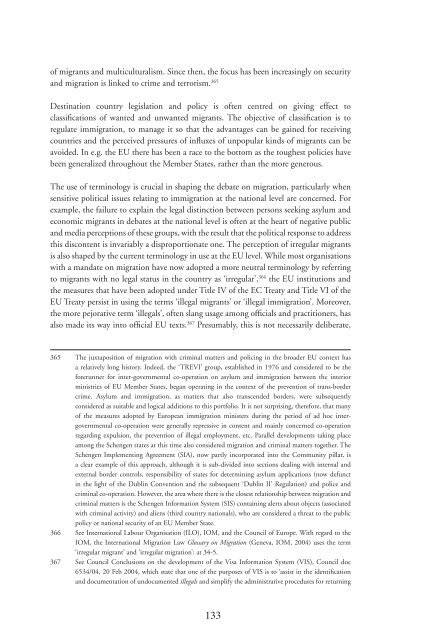Trafficking in human beings: human rights and ... - unesdoc - Unesco
Trafficking in human beings: human rights and ... - unesdoc - Unesco
Trafficking in human beings: human rights and ... - unesdoc - Unesco
You also want an ePaper? Increase the reach of your titles
YUMPU automatically turns print PDFs into web optimized ePapers that Google loves.
of migrants <strong>and</strong> multiculturalism. S<strong>in</strong>ce then, the focus has been <strong>in</strong>creas<strong>in</strong>gly on security<br />
<strong>and</strong> migration is l<strong>in</strong>ked to crime <strong>and</strong> terrorism. 365<br />
Dest<strong>in</strong>ation country legislation <strong>and</strong> policy is often centred on giv<strong>in</strong>g effect to<br />
classifi cations of wanted <strong>and</strong> unwanted migrants. The objective of classifi cation is to<br />
regulate immigration, to manage it so that the advantages can be ga<strong>in</strong>ed for receiv<strong>in</strong>g<br />
countries <strong>and</strong> the perceived pressures of <strong>in</strong>fl uxes of unpopular k<strong>in</strong>ds of migrants can be<br />
avoided. In e.g. the EU there has been a race to the bottom as the toughest policies have<br />
been generalized throughout the Member States, rather than the more generous.<br />
The use of term<strong>in</strong>ology is crucial <strong>in</strong> shap<strong>in</strong>g the debate on migration, particularly when<br />
sensitive political issues relat<strong>in</strong>g to immigration at the national level are concerned. For<br />
example, the failure to expla<strong>in</strong> the legal dist<strong>in</strong>ction between persons seek<strong>in</strong>g asylum <strong>and</strong><br />
economic migrants <strong>in</strong> debates at the national level is often at the heart of negative public<br />
<strong>and</strong> media perceptions of these groups, with the result that the political response to address<br />
this discontent is <strong>in</strong>variably a disproportionate one. The perception of irregular migrants<br />
is also shaped by the current term<strong>in</strong>ology <strong>in</strong> use at the EU level. While most organisations<br />
with a m<strong>and</strong>ate on migration have now adopted a more neutral term<strong>in</strong>ology by referr<strong>in</strong>g<br />
to migrants with no legal status <strong>in</strong> the country as ‘irregular’, 366 the EU <strong>in</strong>stitutions <strong>and</strong><br />
the measures that have been adopted under Title IV of the EC Treaty <strong>and</strong> Title VI of the<br />
EU Treaty persist <strong>in</strong> us<strong>in</strong>g the terms ‘illegal migrants’ or ‘illegal immigration’. Moreover,<br />
the more pejorative term ‘illegals’, often slang usage among offi cials <strong>and</strong> practitioners, has<br />
also made its way <strong>in</strong>to offi cial EU texts. 367 Presumably, this is not necessarily deliberate,<br />
365 The juxtaposition of migration with crim<strong>in</strong>al matters <strong>and</strong> polic<strong>in</strong>g <strong>in</strong> the broader EU context has<br />
a relatively long history. Indeed, the ‘TREVI’ group, established <strong>in</strong> 1976 <strong>and</strong> considered to be the<br />
forerunner for <strong>in</strong>ter-governmental co-operation on asylum <strong>and</strong> immigration between the <strong>in</strong>terior<br />
m<strong>in</strong>istries of EU Member States, began operat<strong>in</strong>g <strong>in</strong> the context of the prevention of trans-border<br />
crime. Asylum <strong>and</strong> immigration, as matters that also transcended borders, were subsequently<br />
considered as suitable <strong>and</strong> logical additions to this portfolio. It is not surpris<strong>in</strong>g, therefore, that many<br />
of the measures adopted by European immigration m<strong>in</strong>isters dur<strong>in</strong>g the period of ad hoc <strong>in</strong>tergovernmental<br />
co-operation were generally repressive <strong>in</strong> content <strong>and</strong> ma<strong>in</strong>ly concerned co-operation<br />
regard<strong>in</strong>g expulsion, the prevention of illegal employment, etc. Parallel developments tak<strong>in</strong>g place<br />
among the Schengen states at this time also considered migration <strong>and</strong> crim<strong>in</strong>al matters together. The<br />
Schengen Implement<strong>in</strong>g Agreement (SIA), now partly <strong>in</strong>corporated <strong>in</strong>to the Community pillar, is<br />
a clear example of this approach, although it is sub-divided <strong>in</strong>to sections deal<strong>in</strong>g with <strong>in</strong>ternal <strong>and</strong><br />
external border controls, responsibility of states for determ<strong>in</strong><strong>in</strong>g asylum applications (now defunct<br />
<strong>in</strong> the light of the Dubl<strong>in</strong> Convention <strong>and</strong> the subsequent ‘Dubl<strong>in</strong> II’ Regulation) <strong>and</strong> police <strong>and</strong><br />
crim<strong>in</strong>al co-operation. However, the area where there is the closest relationship between migration <strong>and</strong><br />
crim<strong>in</strong>al matters is the Schengen Information System (SIS) conta<strong>in</strong><strong>in</strong>g alerts about objects (associated<br />
with crim<strong>in</strong>al activity) <strong>and</strong> aliens (third country nationals), who are considered a threat to the public<br />
policy or national security of an EU Member State.<br />
366 See International Labour Organisation (ILO), IOM, <strong>and</strong> the Council of Europe. With regard to the<br />
IOM, the International Migration Law Glossary on Migration (Geneva, IOM, 2004) uses the term<br />
‘irregular migrant’ <strong>and</strong> ‘irregular migration’: at 34-5.<br />
367 See Council Conclusions on the development of the Visa Information System (VIS), Council doc<br />
6534/04, 20 Feb 2004, which state that one of the purposes of VIS is to ‘assist <strong>in</strong> the identifi cation<br />
<strong>and</strong> documentation of undocumented illegals <strong>and</strong> simplify the adm<strong>in</strong>istrative procedures for return<strong>in</strong>g<br />
133

















